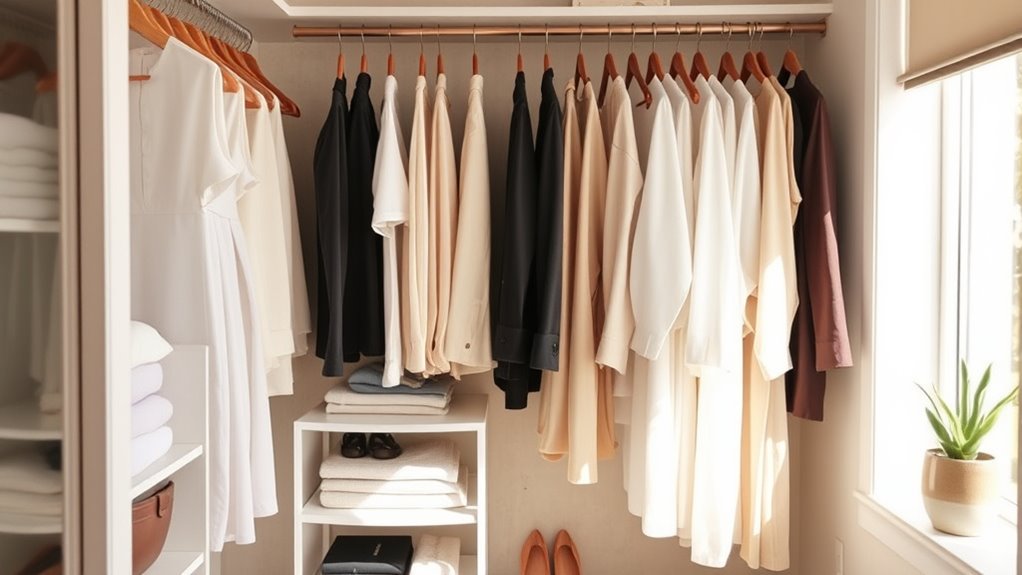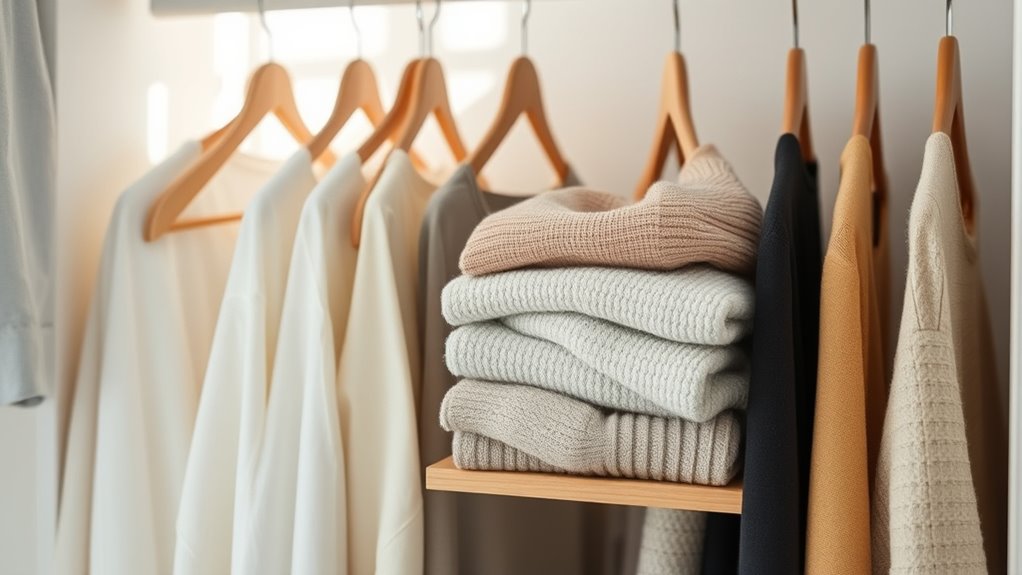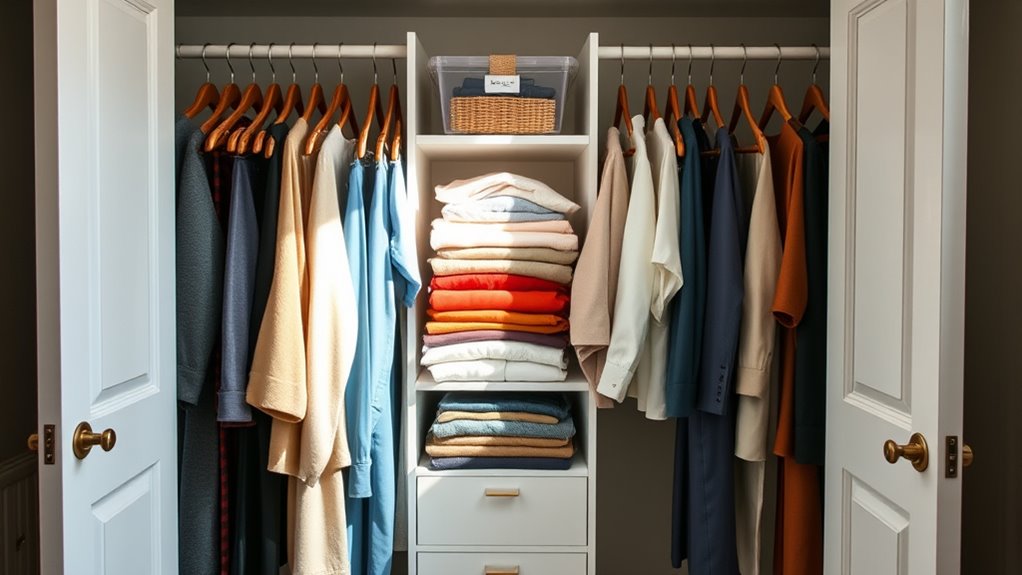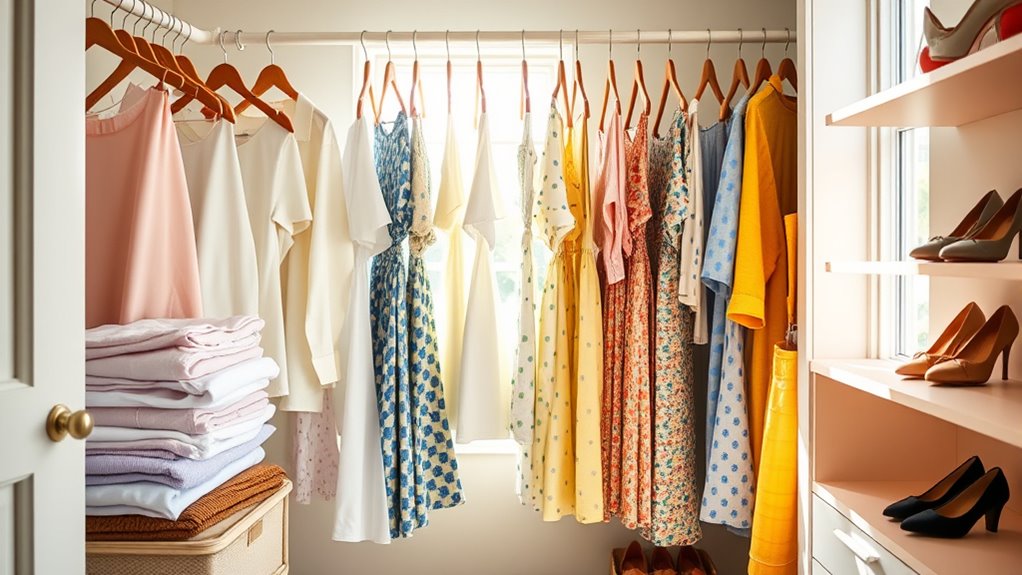A mindful closet purge helps you create a calm, organized wardrobe that boosts confidence and reduces stress. By evaluating your clothes with the need, love, and wear rule, you can let go of items that no longer serve you while honoring meaningful pieces. Simplifying your wardrobe not only makes mornings easier but supports sustainable habits through donation and resale. To discover practical strategies that bring clarity and joy, explore more about transforming clutter into confidence.
Key Takeaways
- Use the Need, Love, Wear rule to evaluate each item and make intentional decluttering decisions.
- Organize your wardrobe with space-saving techniques like vertical storage and clear bins for seasonal items.
- Create a capsule wardrobe with versatile, high-quality pieces to simplify choices and reduce clutter.
- Practice mindful shopping by assessing necessity and avoiding impulse buys to prevent future clutter.
- Donate, resell, or swap clothes to give items a second life and maintain a clutter-free wardrobe.
The Therapeutic Power of Decluttering

Decluttering your closet can be a surprisingly therapeutic experience, offering more than just tidiness. When you remove items you no longer need, you create space for mental clarity and emotional relief. Many people find that letting go of clothes helps reduce feelings of overwhelm and stress. It’s not just about physical space; it’s about reclaiming control over your environment. As you sort through your wardrobe, you might notice emotional attachments easing, making room for new beginnings. Decluttering can boost your mood and sense of accomplishment, especially when you see the tangible results of your efforts. This process can serve as a form of self-care, helping you feel lighter, more organized, and more in tune with your needs. Being mindful during this process can also foster a sense of emotional well-being that extends beyond your closet.
Benefits of Simplifying Your Wardrobe

Simplifying your wardrobe not only clears physical space but also brings numerous mental and emotional benefits. With fewer clothes, you spend less time deciding what to wear, reducing decision fatigue and making mornings smoother. A streamlined closet helps boost your confidence because you own items that fit well and reflect your personal style. It also aligns your wardrobe with your current lifestyle, making dressing more practical and enjoyable. Plus, a simplified wardrobe reduces clutter, which can lower stress and create a sense of calm. By focusing on quality over quantity, you save money and avoid impulse buys. Additionally, embracing mindful clothing choices supports sustainable practices and reduces environmental impact. Overall, this approach makes your daily routine easier, supports mindful consumption, and promotes a more intentional, satisfying relationship with your clothing.
Recognizing Emotional Attachments to Clothing

You might find it hard to let go of certain clothes because they hold emotional significance or remind you of special moments. Nostalgia can make it challenging to part with items that represent memories or personal milestones. Recognizing these emotional attachments helps you navigate the letting go process more mindfully and intentionally, and understanding the emotional impact of your wardrobe can facilitate a healthier relationship with your clothing.
Emotional Significance of Items
Emotional attachments often make it difficult to part with certain clothing items, as they carry memories, milestones, or feelings of comfort. You might hold onto a dress from a special event or a sweater given by someone important. These items symbolize moments or relationships that feel meaningful. Recognizing these attachments is essential during your closet purge. Instead of dismissing your feelings, acknowledge their importance. Ask yourself why you’re attached and whether keeping the item serves a current purpose. Sometimes, preserving the memory doesn’t require holding onto the physical item. By understanding your emotional ties, you can make mindful decisions, finding balance between honoring your past and creating space for new experiences. Being aware of emotional significance can help you approach decluttering with compassion and clarity.
Nostalgia and Memories
Nostalgia and memories often deepen the emotional connections you have with certain clothing items, making it harder to let them go. You might hold onto that old concert T-shirt because it reminds you of a special night, or keep a vintage dress because it echoes a past chapter of your life. These attachments aren’t just about the clothing—they’re about the moments, feelings, and identities tied to them. Recognizing this helps you understand why parting with certain items feels so difficult. Instead of dismissing these feelings, honor them. Take photos of meaningful pieces before letting them go or create a memory box. This way, you preserve the sentiment without cluttering your space, making your wardrobe purge a mindful and respectful process. Additionally, understanding the role of emotional attachments in decision-making can aid in approaching your decluttering journey with compassion and clarity.
Letting Go Challenges
Letting go of clothing items can be challenging because they often carry deep emotional attachments that are hard to ignore. You might hesitate to part with pieces tied to memories or significant life moments. To overcome this, consider these strategies:
- Identify the true value: Ask if the item serves a current purpose or if it’s just holding sentimental weight.
- Create a memory box: Store special pieces separately to preserve memories without cluttering your closet.
- Set a limit: Decide on a specific number of sentimental items to keep, helping balance attachment with practicality.
- Recognize the resale value of your clothing to determine if it can be repurposed or sold instead of keeping it unused.
Recognizing why you’re hesitant allows you to make mindful decisions. Remember, releasing emotional attachments can be freeing and pave the way for a more intentional wardrobe.
Implementing the Need, Love, Wear Rule

Implementing the Need, Love, Wear rule is a straightforward way to streamline your wardrobe and make decluttering more intentional. Start by evaluating each item with these three questions: Do I need it? Do I love it? Do I wear it regularly? If the answer to any of these is no, it’s time to let go. Focus on keeping clothing that serves a purpose, brings joy, and fits into your current lifestyle. This rule helps you avoid keeping items out of guilt or emotional attachment, encouraging mindful decisions. As you sort through your wardrobe, you’ll find it easier to identify what truly belongs and what’s better donated or recycled. Incorporating clothing maintenance techniques can also extend the lifespan of your favorite pieces, making your wardrobe more sustainable. Consistently applying the Need, Love, Wear rule fosters a more functional, enjoyable, and clutter-free closet.
Strategies for a Seasonal Closet Refresh

A seasonal closet refresh is a proactive way to keep your wardrobe organized and aligned with your current needs. To make it effective, follow these strategies:
- Sort and Assess: Remove everything, then evaluate each item based on need, love, and wear. Keep only what fits your current lifestyle.
- Rotate and Store: Pack away out-of-season clothes in labeled bins or under-bed storage. Bring forward pieces suited for the upcoming season.
- Re-evaluate and Edit: After sorting, identify gaps or duplicates. Use this insight to plan purchases conscientiously, avoiding clutter buildup.
This process keeps your wardrobe fresh, minimizes decision fatigue, and ensures you wear what truly serves you now. Regular refreshes promote clarity and align your closet with your evolving style.
Creating a Capsule Wardrobe for Ease and Sustainability

By choosing versatile pieces, you can create a wardrobe that works for any occasion without clutter. Maintaining a minimal wardrobe helps you stay organized and reduces decision fatigue. With thoughtful selection and regular updates, you’ll enjoy an easier, more sustainable approach to dressing.
Selecting Versatile Pieces
Selecting versatile pieces is essential for building a capsule wardrobe that’s both practical and sustainable. These items form the foundation of your closet, making dressing effortless and reducing clutter. Focus on pieces that easily mix and match, serve multiple occasions, and suit your style. To get started:
- Choose neutral colors like black, white, or beige for easy pairing.
- Prioritize classic styles that won’t go out of fashion.
- Invest in high-quality fabrics that last longer and withstand regular wear.
- Incorporate timeless design elements, such as rustic accents, to add charm and cohesion to your wardrobe.
Maintaining Minimal Wardrobe
Maintaining a minimal wardrobe keeps your closet organized and reduces decision fatigue, making daily dressing simpler and more sustainable. To do this, regularly review your clothing, keeping only items that still fit, suit your style, and serve your needs. Practice the one-in-one-out rule: when you add a new piece, remove an old one. Focus on versatile, high-quality staples that can be mixed and matched easily. Store seasonal items properly to avoid clutter and revisit your wardrobe every few months to reassess. Be mindful of your shopping habits to prevent unnecessary accumulation. Incorporating clothing organization techniques can help maintain a streamlined wardrobe. Embracing this ongoing maintenance guarantees your wardrobe remains streamlined, functional, and aligned with your lifestyle, while also supporting sustainable fashion practices.
Storage Solutions to Maximize Space

Maximizing closet space becomes much easier when you incorporate smart storage solutions that fit your needs. First, use vertical space with stackable shelves or hanging organizers to keep items accessible without cluttering the floor. Second, invest in slim, velvet hangers to save space and prevent clothes from slipping off. Third, consider clear stackable bins for seasonal items or accessories, making it simple to find what you need quickly. Drawer dividers help organize smaller items like underwear or jewelry, while door hooks or over-the-door racks add extra storage for belts, scarves, or bags. Incorporating appropriate storage options can further optimize your closet layout and functionality. These simple solutions streamline your closet, keep things tidy, and make it easier to see and access your wardrobe essentials, ultimately making the most of your space.
Making Mindful Choices: Buying Less, Owning More

By organizing your closet with smart storage solutions, you’ve set the stage for a more intentional approach to your wardrobe. Now, focus on making mindful choices when purchasing new clothes. Before buying, ask yourself if you truly need the item and if it complements your existing wardrobe. Opt for quality over quantity, investing in versatile pieces that can mix and match easily. Avoid impulsive buys by creating a shopping list and sticking to it. Consider how often you’ll wear an item and whether it aligns with your lifestyle. Remember, owning fewer high-quality pieces reduces clutter and boosts confidence. Practicing mindful consumption helps you enjoy your wardrobe more and supports sustainable fashion habits. Ultimately, buying less encourages you to cherish what you own.
Giving Clothes a Second Life Through Donation and Resale

When you donate or resell your unwanted clothes, you extend their life and help reduce waste. By choosing sustainable giving options, you support ethical fashion practices and benefit those in need. Maximizing the secondhand value of your items makes your decluttering effort more impactful and environmentally friendly.
Sustainable Giving Options
Giving clothes a second life through donation and resale offers a sustainable way to declutter your closet while supporting environmental and social causes. By choosing these options, you extend the lifespan of your garments and reduce waste. Here’s how you can maximize your efforts:
- Identify items in good condition that you no longer wear, and donate them to local charities or shelters. Your clothes can brighten someone’s day and support community programs.
- Research resale platforms to sell gently used clothing online, which helps fund your sustainable habits while earning extra cash.
- Organize a clothing swap with friends or neighbors—an eco-friendly way to refresh your wardrobe without buying new items.
These practices minimize waste, promote reuse, and make your decluttering process more impactful.
Maximizing Secondhand Value
Maximizing the secondhand value of your clothes transforms your decluttering efforts into a sustainable practice that benefits both the environment and your wallet. Start by sorting items into categories: donate, resell, or repurpose. For resale, clean and repair clothes to increase their appeal and value. Use online platforms like Poshmark, Depop, or ThredUp to reach buyers who appreciate pre-owned fashion. Donating clothes to charities gives them a second life while supporting good causes. When donating, ensure items are in good condition to avoid waste. Consider local thrift stores or clothing drives. By thoughtfully reselling or donating, you extend your wardrobe’s lifespan, reduce waste, and contribute to a more sustainable fashion cycle. This approach transforms clutter into eco-friendly, budget-friendly opportunities.
Maintaining a Streamlined Wardrobe for Long-Term Happiness

Maintaining a streamlined wardrobe requires consistent effort and mindful habits that support long-term happiness. To keep your closet organized and fulfilling, focus on these key practices:
- Practice the Need, Love, Wear Rule—regularly evaluate items to keep only what you need, love, and wear often.
- Adopt the One-In-One-Out Policy—replace older or unused pieces each time you add something new.
- Schedule Seasonal Refreshes—dedicate time every 6-12 months to reassess your wardrobe, donating or selling what no longer serves you.
These habits help prevent clutter buildup, encourage mindful purchasing, and ensure your wardrobe remains aligned with your lifestyle. Consistency keeps your closet manageable, making dressing effortless and supporting your happiness in the long run.
Frequently Asked Questions
How Can I Start Decluttering if I Feel Overwhelmed?
If you feel overwhelmed, start small by setting a timer for 10-15 minutes and tackling one area, like a drawer or a section of your closet. Use the need, love, wear rule to decide what stays. Take breaks, and remember, decluttering is a process, not a one-day fix. Celebrate small wins, and gradually work your way up to more significant sections. This approach keeps it manageable and reduces stress.
What Are the Best Digital Tools for Wardrobe Management?
You’ll want to explore digital wardrobe management tools like Stylebook, Closet+, or Smart Closet. These apps let you catalog your clothes, plan outfits, and track usage, making decluttering easier. Use their features to identify what you wear most, set reminders for seasonal refreshes, and visualize your wardrobe. With these tools, you’ll stay organized, make mindful choices, and maintain a simplified closet effortlessly.
How Do I Handle Emotional Attachment to Sentimental Clothing?
Imagine your emotional attachment to sentimental clothing as holding onto a delicate keepsake. You might keep a childhood shirt because it represents a cherished memory. To handle this, take photos of the item to preserve the memory without the clutter. Remind yourself that memories aren’t in the clothes—they’re in your heart. Letting go can be freeing, allowing space for new experiences while still honoring the past.
What Are Sustainable Ways to Dispose of Unwanted Clothes?
You can dispose of unwanted clothes sustainably by donating them to charities or shelters if they’re in good condition. If not, consider recycling programs or textile donation centers that repurpose fabric. Selling items secondhand also extends their life. Avoid throwing clothes in the trash to reduce waste, and look for local initiatives or eco-friendly brands that focus on recycling or upcycling textiles. Your mindful disposal supports environmental sustainability and helps those in need.
How Often Should I Reassess My Wardrobe for Optimal Organization?
You should reevaluate your wardrobe every 6 to 12 months to keep it organized and functional. Regular checks help you identify items you no longer need, love, or wear, making space for essentials. Use this time to declutter, donate or sell clothes in good condition, and update your wardrobe based on your current lifestyle. Staying consistent with reassessment ensures your closet remains streamlined, stress-free, and aligned with your needs.
Conclusion
By decluttering your wardrobe mindfully, you release a sense of freedom that’s almost miraculous. Embrace the power of letting go, making space for what truly brings you joy. When you apply these simple strategies, your closet transforms into a sanctuary of calm and clarity. Remember, every item you keep should serve a purpose, love, or be worn. With this approach, your wardrobe—and your life—becomes lighter, brighter, and more beautifully aligned with who you are.









